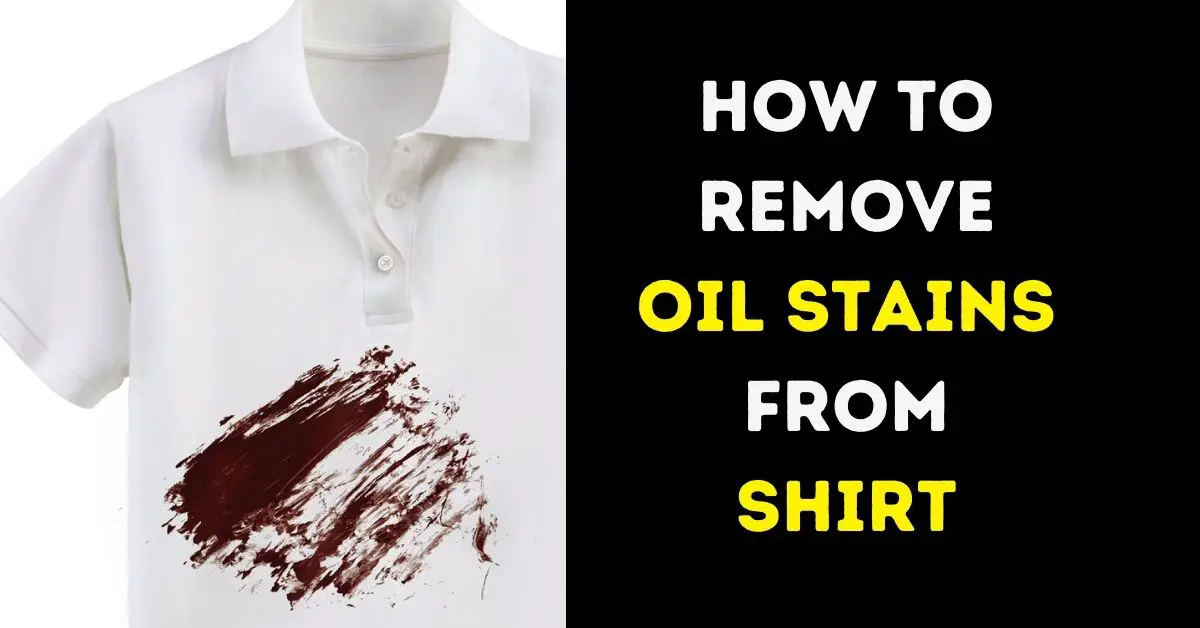
Oil stains on shirts can be incredibly frustrating. Whether it’s cooking oil or motor oil, these stains can quickly ruin your favorite garments. Taking quick action is essential to prevent permanent damage. In this post, I’ll provide you with a simple and effective cleaning process to tackle oil stains and keep your shirts looking good. So, how to remove oil stains from shirt? to get rid of those pesky stains and have a stain-free wardrobe!
Step-By-Step Guide on How to Remove Oil Stains from Shirt

Step 1: Type of Oil Stain
Identify the type of oil stain for effective removal. Cooking oil and motor oil stains have distinct properties that impact how they bond with fabric fibers and respond to cleaning agents. Consider fabric type too; cotton and polyester are forgiving, while delicate fabrics like silk or wool need extra care during stain removal.
Step 2: Pre-Cleaning Steps
- Blot excess oil: Use a clean cloth or paper towel to gently blot the stain, avoiding rubbing.
- Avoid heat and hot water: Prevent setting the stain by refraining from hot water or direct sunlight exposure.
- Use talcum powder or cornstarch: Sprinkle and let it sit to absorb the remaining oil before brushing off.
Step 3: Choosing the Right Cleaner and Cleaning Method
- Household items: Dish soap, baking soda, and white vinegar are gentle yet effective options for lifting oil stains from various fabrics.
- Commercial stain removers: Look for products formulated for oil stain removal and follow the instructions provided by the manufacturer.
- Avoid harsh chemicals: Opt for milder alternatives and test them in a hidden area before applying to the stained spot.
Step 4: Step-by-Step Cleaning Process
The key to easily removing oil stains from shirts lies in a systematic and careful cleaning process. Follow these step-by-step instructions to effectively bid farewell to those stubborn stains:
- Testing for colorfastness in a hidden area: Before treating the oil stain, apply a small amount of the cleaning agent in an inconspicuous area. Wait a few minutes to check for any discoloration or damage. Proceed if there are no adverse reactions.
- Applying the chosen cleaner on the stain: Once you’ve confirmed the cleaner is safe to use, apply it directly to the oil stain. Depending on your chosen method, you might use dish soap, baking soda paste, white vinegar, or a commercial stain remover. Just add a few drops to cover the affected stain.
- Gently rub the stain with a clean cloth or soft brush: Using a clean cloth or soft-bristled brush, gently work the cleaning agent into the stain using circular motions. Avoid scrubbing too aggressively, as this may cause the stain to spread or damage the fabric. Instead, allow the cleaning agent to penetrate the stain, breaking down the oil particles.
- Rinsing and checking the stain’s status before proceeding: After treating the stain, rinse the area thoroughly with cold water. Check the status of the stain to see if it has lightened or disappeared completely. If the stain is still visible, repeat the cleaning process until you achieve the desired results.
Important Tips:
- Always use cold water for rinsing, as hot water can set the oil stain and make it more challenging to remove.
- Avoid using heat (such as a clothes dryer) on the stained area until the stain is entirely gone, as heat can further set the stain.
- If you notice the stain is stubborn or not responding to your initial cleaning efforts, consider using an alternative cleaning agent or seeking professional help.
Remember, patience and persistence are key when dealing with oil stains on shirts. Depending on the fabric type and the age of the stain, it may take several attempts to completely eliminate it. Taking immediate action and following this step-by-step cleaning process will maximize your chances of success, leaving your shirts spotless and ready to wear once again.
Preventing Oil Stains
While dealing with oil stains can be bothersome, taking preventive measures can save you the trouble in the first place. Here are some simple yet effective tips to help you keep oil stains at bay:
Wearing aprons while cooking or working with oils:
One of the easiest ways to prevent oil stains on your shirts is to wear an apron whenever you’re cooking or handling oils. Aprons act as a protective barrier, shielding your clothes from accidental spills and splatters. Whether you’re frying, sautéing, or barbecuing, wearing an apron will not only keep your clothes clean but also add a touch of style to your culinary adventures.
Keeping a stain removal kit handy for emergencies:
Accidents can happen even with the utmost care, so it’s wise to be prepared for unexpected oil spills. Create a stain removal kit and keep it within easy reach in your laundry area or kitchen. Your kit should include items like stain removers, white cloths, gentle detergent, and maybe even some baking soda or cornstarch. Having these items readily available will enable you to act quickly and effectively to minimize the damage when an oil spill occurs.
